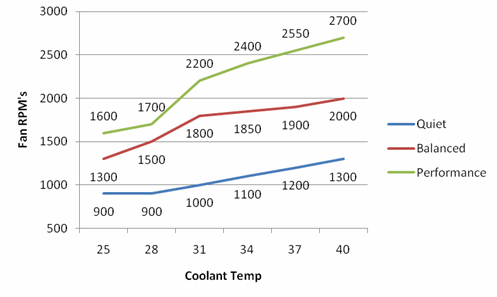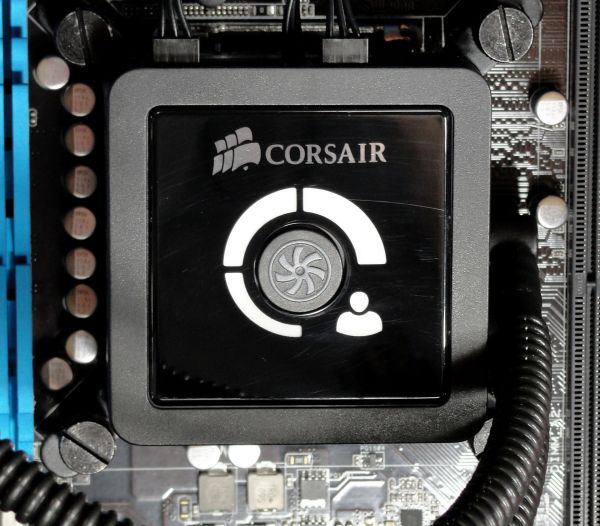Corsair Hydro Series: H60, H80 and H100 Reviewed
by Jared Bell on November 7, 2011 12:00 AM EST- Posted in
- Cases/Cooling/PSUs
- Corsair
- Water Cooling
H60, H80, and H100 Overview
As always with Corsair products, packaging and box art are top notch. We’ll start with the lowest tier offering, the H60, and then move to the H80 and H100.
H60 High Performance Details
The H60's radiator is the same size of the previous generation H50. However, the H60 has a new, upgraded water block that allows for more efficient flow. It also has the adjustable 90 degree connectors we've seen on the H70 making installation easier. Corsair provides a single 120mm 1700RPM PWM fan. The inclusion of a PWM fan is a nice touch since most motherboards have the needed 4-pin connector and have BIOS settings for easy fan speed control. This means the cooler can be virtually silent when idle, but ramp up the RPMs (and therefore noise) as needed. As mentioned, the H60 only includes one fan, but you can add a second fan for a push/pull configuration. You'll just need to pick up an extra set of 6x32x1-1/4" screws.
H80 High Performance
The H80 takes over for the H70 with its thicker radiator design but shares the same new, upgraded water block as the H60. However, the H80 and the H100 have an all new push-button fan control that lets you select the fan speed and cooling performance setup that best suits your needs. The white LED display lets you know which profile is being used. The H80 can power and control up to two fans. Thankfully, like the H70 before it, the H80 already comes with two fans for a push/pull configuration. The included fans are 3-pin and spin at 2500RPM when the fan controller is set to its highest setting. We’ll provide more information on the fan speed profiles later.
H100 Extreme Performance
The H100 is an all new double-wide design sporting a 240mm [or 2x120mm] radiator that has the same thickness as the H60. The water block and fan controller are the same that we've seen on the H80; however, the H100's fan controller can power and control up to four fans even though the unit only comes with two. This gives you the option of adding two more fans for push/pull on this bad boy. The two included fans are the same high speed 2500RPM fans that come with the H80.
Fan Controller
The three speed push-button fan controller on the H80 and H100 is a great improvement over what Corsair offered previously with the H70. The H70 included two inline resistors for providing a second, lower fan speed. The new built-in fan control system on the H80 and H100 gives you three settings to choose from: low, medium, or high—or as Corsair calls it: low noise, balanced, and high performance. While some may complain you have to open your case to make changes, I think of it as more of a set it and forget it type thing. Corsair doesn't stop there though; each speed setting or profile actually has an RPM range for the fans to spin at. This means the fans will be quieter when idle and only reach their max rated RPM (and max noise) for that particular profile when the coolant inside reaches a certain temperature. Could this lead to the perfect balance of performance and noise? We'll hopefully find out with our tests in just a moment.

Corsair Link
The H80 and H100 both support Corsair's Link Digital, which is their suite of hardware and software for monitoring various system parameters. It also allows you to customize your own performance profiles. We don't have one of the Corsair Link's on hand, so we will not be testing this feature. It's unfortunate that Corsair doesn't include the Link with the H80 or H100, but I'm guessing they opted to make it optional so the price wouldn't go through the roof.



























91 Comments
View All Comments
n13L5 - Monday, August 27, 2012 - link
ooops necro alert....JPForums - Monday, November 7, 2011 - link
<quote>(English is my 2nd language so I'm not sure I use all words 100% correctly. Hope I'm understandable.) </quote>Quite.
Also, you seem to have a good understanding of how liquid cooling systems work, and for all practical purposes I agree with you statements.
However, in regards to the function of reservoirs, there are a few technicalities that could dispute your statements in theory, but not in common practice.
First, if the reservoir is made of a thermally conductive material and has good thermal contact with the chassis in which it is mounted, it can remove heat conductively. Commonly, reservoirs are made of plastic and thus provide no effective cooling. As you alluded to earlier, you would need a massive surface area of liquid to radiate an appreciable amount of heat. Further, as most of this heat is lost as liquid turns to vapor (Read: liquid loss), it would not be in your best interest to rely on such a system.
Second, larger volumes of liquid would take longer to heat. If you were to take measurements of two similar systems with varying volumes of liquid, you would find that the system with less liquid would reach steady state temperatures more quickly. If you compared temperatures without making sure the second system reached steady state, then you might indeed conclude that the extra volume of liquid was beneficial to cooling. However, upon reaching steady state, both systems would perform more or less the same.
Again, in practice the reservoir does little to add to the cooling capability of the system.
Death666Angel - Monday, November 7, 2011 - link
Good addition to my post and of course, very true. :-)martyrant - Monday, November 7, 2011 - link
I just have a $30 enzotech cpu block, $5 casa depot homer bucket, $15 eco 264 pump (using 1/2" tubing), and let me tell you, compared to every other "pc built water cooling system" whether I pieced it together of expensive parts off frozencpu or bought a kit, this is by far the best cooling setup I've ever ran. No radiator. Just a 5 gallon bucket of distilled water. If you are worried about algae or other goodies, just run h2o2 (hydrogen peroxide) with it [don't use the medical stuff, grab the stuff that is like 30% h2o2]. Sometimes I can't believe how much I used to spend on this crap. Sure, it's not that portable [but who moves their water cooled computer anyway--you are supposed to drain/fill everytime you do with the other custom kits], and it either loses/gains wow factor depending on how you look at it (I love showing off my ghetto cooling setup that beats the pants off everything beyond going chilled water). The only upgrade would be a car radiator...hah.double0seven - Tuesday, November 8, 2011 - link
It sounds like it is working for you this way, but have you ever wondered why your windows keep fogging up? And the underside of your desk is moldy?martyrant - Sunday, November 13, 2011 - link
It's got a lid, I cut out holes, it's semi-sealed...and even if it wasn't, those wouldn't be an issue...do you know what you are talking about?jewie27 - Sunday, November 20, 2011 - link
they use a 240MM radiator because they are only meant to cool the CPU not the entire system with GPU's...Wakanabi - Monday, February 13, 2012 - link
I just overclocked a new FX4100 cpu from 3.6 to 4.6Ghz per core, quad core, in a NZXT M59 case and using a corsair H60 $60 liquid solution I ran prime95 overnight. Completely stable and better yet the cpu never eclipsed 38 degrees celcius. On top of that it has been idling at 8-15celcius. Compare that to stock or even aftermarket fans.Even the cheap H60 does an amazing job at cooling. Naysayers simply haven't tried them. The H100 in my HAF case is even more amazing with my core i7 cpu.
ashujmc - Monday, August 25, 2014 - link
You make a water cooler with a Radiator surface area equivalent to that of those Huge air coolers, you will get better performance.. additionally, not to forget that Air coolers, However massive, release all their heat Inside the CPU cabinet itself.. so HEATING THE OTHER COMPONENTS.... so heat washout from the cabinet will depend on Air flow through cabinet.. and to make the matter worse, they Obstruct Air flow inside the cabinet due to their Huge size... but Water cooler radiators will release the heat outside the cabinet.. so less heat trapped inside.. and due to smaller nature of main unit, won't block the air flow much.. if at all...zodiacfml - Tuesday, November 8, 2011 - link
surface area. that is why these sealed water cooling kits perform better with faster fan speeds. yet, they still make sense when you have a moderate target cooling capacity like cooling a Sandy Bridge.